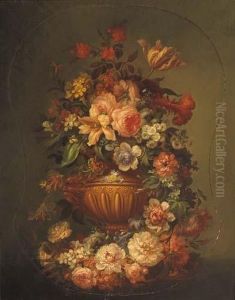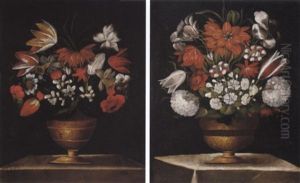Auguste Bouquet Paintings
Auguste Bouquet was a French lithographer and caricaturist born in the early 19th century, a period that saw significant political, social, and artistic shifts in France and across Europe. His birth year, 1810, positioned him in a time when the Napoleonic Wars were reshaping the continent, and the subsequent Restoration and July Monarchy periods would influence his formative and active years as an artist. Bouquet's death in 1846 came just before the revolutionary waves of 1848 that once again transformed Europe, marking his career as one encapsulated within a particularly tumultuous era.
Bouquet's work is best remembered for its sharp wit and its role in the burgeoning culture of lithographic arts during the 19th century. Lithography, having been invented in the late 18th century, was gaining popularity as a medium for both artistic expression and political commentary, thanks to its ability to produce images relatively quickly and inexpensively. Bouquet harnessed this new medium to contribute significantly to the period's visual commentary, often focusing on the societal and political issues of his day. His caricatures are known for their keen observation and the ability to distill complex ideas into visually engaging and often humorous images, a talent that made his work accessible and influential among a wide audience.
Though specific details of Bouquet's life are less documented than those of his contemporaries, his artistic output suggests he was deeply engaged with the intellectual and political currents of his time. His collaborations with notable writers and publishers of the era indicate his integration into the vibrant cultural milieu of 19th-century France, particularly in Paris, which was a hub for artists, writers, and thinkers. Despite his relatively short life, Bouquet's contributions to the world of lithography and caricature left a lasting imprint on French art, offering insight into the complexities and challenges of his era through the lens of satire and visual critique.
Unfortunately, Bouquet's work, like that of many artists of his time, has not always been widely recognized in the broader narrative of 19th-century art history, overshadowed perhaps by the towering figures of Romanticism, Realism, and the later Impressionist movements that dominate this period. Nonetheless, for those interested in the evolution of printmaking and political art in Europe, Bouquet's lithographs offer a fascinating glimpse into the visual culture of a society in transition. His death in 1846 marked the end of a brief but impactful career, leaving behind a body of work that continues to be studied for its artistic merit and historical significance.


